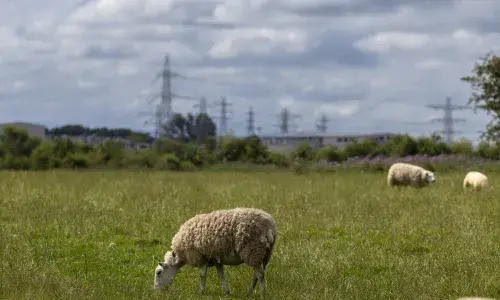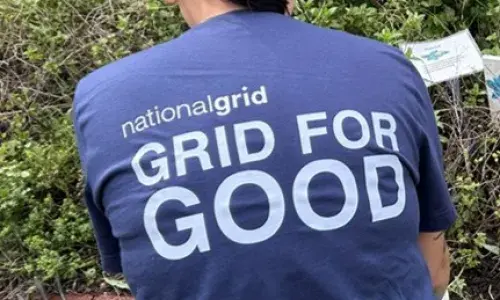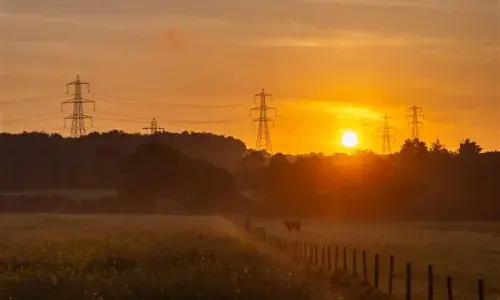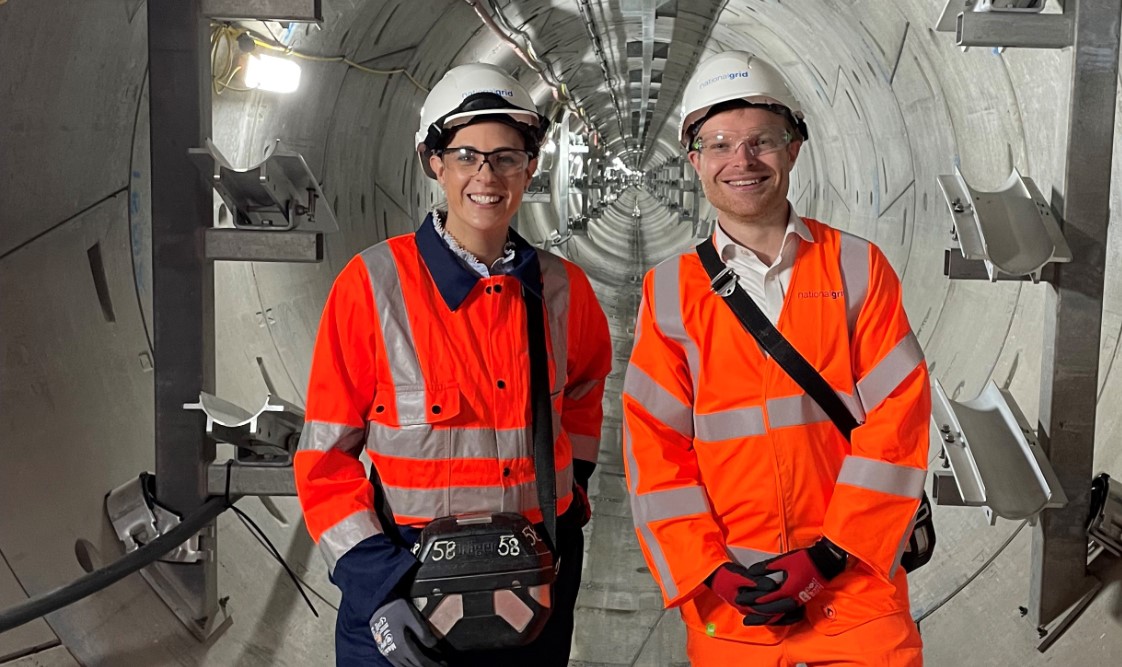
National Grid switches on first London Power Tunnels circuit as energy minister visits
- 2.5km circuit between Hurst substation and Crayford is now energised
- Minister for Energy, Michael Shanks, visits project as key milestone is reached
- Work continues on remaining 30km of circuits between Hurst and Wimbledon to reinforce the capital’s electricity network
Energy minister Michael Shanks visited National Grid’s £1 billion London Power Tunnels 2 (LPT2) project as engineers energised the first of its six new electricity transmission circuits installed deep underground in South London.
The energisation sees 2.5km of new high voltage 275kV network made live between Hurst substation and Crayford – a tunnel route averaging 35 metres below ground which was completed by Christine the tunnel boring machine last year.
Mr Shanks visited New Cross substation, a key site at which work is ongoing on the project’s two other double circuits – one between Wimbledon substation and New Cross (12km), the other between New Cross and Hurst (18km).
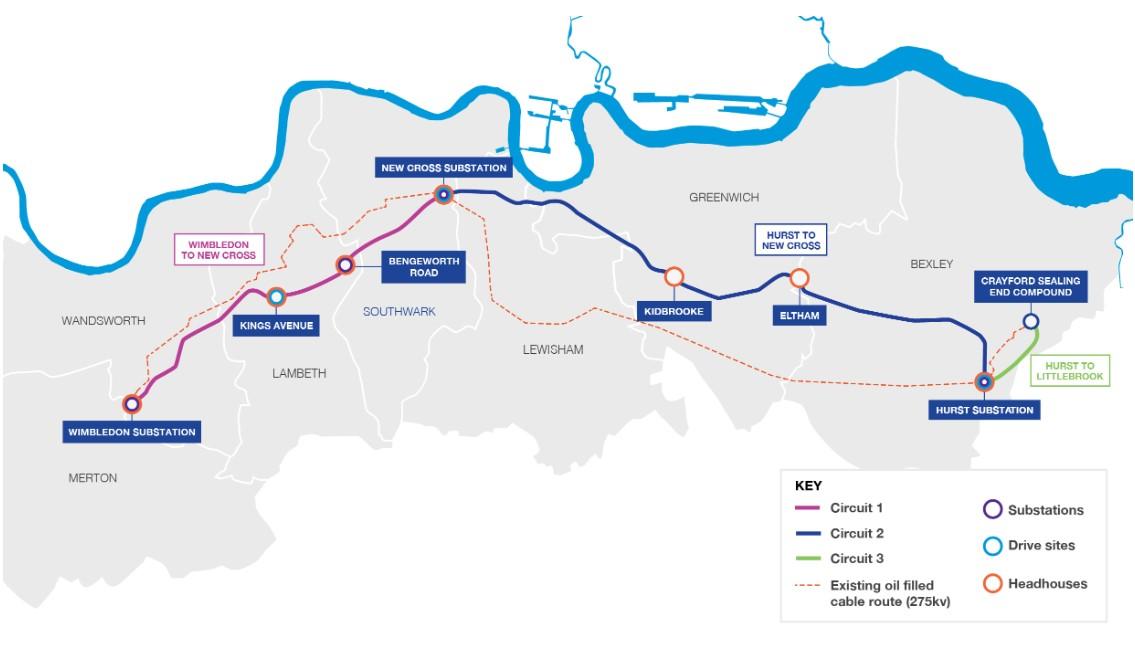
Also under construction on the 32.5km LPT2 route is a new substation at Bengeworth Road, which – in a UK-first – is being built using SF6-free gas insulated switchgear technology.
The previous cables between Hurst and Crayford were reaching the end of their operational life, having been commissioned in 1967 and having served London reliably for decades.
While the old cables were buried in shallower trenches in the streets, the LPT2 network carries power in three metre wide tunnels deep beneath the road network, with vertical shafts between 9-15 metres wide and up to 55 metres deep sitting above the tunnels at key points along each circuit, each one covered by a headhouse.
The headhouses and shafts provide ventilation and safe access for project teams, meaning less construction and maintenance disruption, and easier future upgrade potential.
Alice Delahunty, president of National Grid Electricity Transmission, said: “We were pleased to welcome the minister at such a milestone moment for London Power Tunnels, and demonstrate the ongoing work to reinforce the city’s network.
“There’s still a way to go on the project, but the Hurst-Crayford circuit seeing volts for the first time is a tremendous achievement for our National Grid teams and supply chain partners.
“It’s hard to overstate what an engineering challenge it has been to build over 30km of tunnels under London to upgrade and futureproof the capital’s electricity supplies, so the project’s progress to date is a real testament to all those involved.”
Energy minister Michael Shanks said: “The London Power Tunnels show British infrastructure at its best and I congratulate the efforts of everyone involved, as this new circuit switches on to power up homes and businesses across the capital.
“It is feats of incredible engineering, such as this, that will be the driving force behind our race to become a clean energy superpower and help to revive communities across the UK with new skilled jobs.”
Since the project to reinforce the capital’s electricity network kicked off in 2020, National Grid has worked closely with supply chain partners to keep the project progressing on schedule and within budget.
Project partners include HOCHTIEF-MURPHY Joint Venture (HMJV) on the tunnels, shafts, headhouses, mechanical and electrical works; Taihan and Balfour Beatty on cable supply and installation respectively; and Linxon on substation works.
Raj Kundan, HMJV project director, said: “Energisation of the first Hurst to Crayford circuit for National Grid serves as a major milestone for the Project 13 Enterprise on what has been a phenomenal journey so far delivering London Power Tunnels 2.
“HMJV and our supply chain family are proud to have played a key part of this with our expertise and readiness to deliver the complexities of the tunnels, shafts, headhouses and M&E infrastructure as well as supporting the wider enterprise.
“The ingenuity and drive of our teams coupled with our ‘One Team, One Spirit’ approach continues to demonstrate our commitment to delivering our client’s desired outcomes whilst leaving a positive legacy – and we look forward to continuing this on the remaining circuits on the project.”
Tony Wilson, managing director of Balfour Beatty UK Power Transmission & Distribution, said: “We are proud to celebrate this significant milestone in partnership with National Grid. Our collaboration on the London Power Tunnels 2 project is a testament to our shared commitment to delivering innovative infrastructure solutions.
“The energisation of the Hurst-Crayford circuit will provide a reliable and resilient power supply to the people of London for generations to come.”
Jongmin Song, CEO of Taihan Cable & Solution, said: “LPT2 is the biggest project that Taihan Cable & Solution have performed in the UK and it is a monumental project to connect the capital’s network. We are immensely proud to be part of the enterprise, and we will be playing a vital role in in the future to reinforce the UK’s transmission network.”
The current London Power Tunnels project is the second phase of a massive endeavour to reinforce the capital’s electricity network in readiness for demand growing in the future.
It follows the completion in 2018 of the first phase – a seven-year, £1 billion project to construct 32km of tunnels and two new substations to rewire the network in North London.
